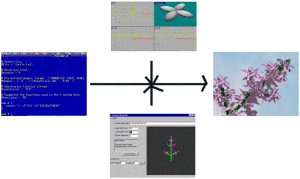 The Parser half of the L-system code is now ready. The Parser consists of a
Perl program (PARAM.PL) containing the Parser code, and another Perl program containing the L-system definitions (rules, constants, algorithms, pre-defined shapes, etc). Unlike other
parsers, this system has the benefit of parsing parametric and stochastic L-systems just as easily as "normal" L-systems. (Context-sensitive L-systems are left as an exercise
for the reader. 8-)
The Parser half of the L-system code is now ready. The Parser consists of a
Perl program (PARAM.PL) containing the Parser code, and another Perl program containing the L-system definitions (rules, constants, algorithms, pre-defined shapes, etc). Unlike other
parsers, this system has the benefit of parsing parametric and stochastic L-systems just as easily as "normal" L-systems. (Context-sensitive L-systems are left as an exercise
for the reader. 8-)
The image on the right is a simple "flowchart" showing how the complete system works. The parser is on the left (barely visible Perl code). The interpreter (bottom) takes pre-defined DXF shapes (if any) from a modeller (top) along with turtle information from the Parser and produces a complete DXF model which can then be used in any rendering engine (right). The model here is my rendition of the "lilac" seen on page 92 of The Algorithmic Beauty of Plants (ABOP). The flower model I created in Rhinocerous while the interpreter and parser created the framework for the complete stalk.
Downloads
- Parser The Perl Parser code along with several example files.
- Interpreter Coming Soon?
